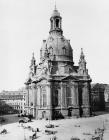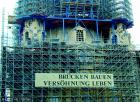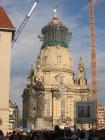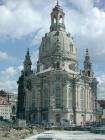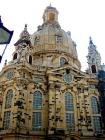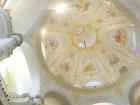Day Trip to the Sächische Schweiz
(the Switzerland of Saxony)
We made a one-day trip on the train to what is called
the Sächische Schweiz, which translates
to the "Switzerland of Saxony". Saxony is a state in the
former East Germany, partly well-known because Walter Ulbricht,
essentially the head of East Germany for 22 years starting
in 1949, came from Saxony and had the characteristic accent
of these Germans. Before the German unification, this was
a vacation spot for those in the East. My son said that
the former east Germans (Ossies) still were the main
ones vacationing there, but the Meier family disputed this,
saying they were trying to attact tourists from all over.
We didn't do a survey to see the breakdown, but there weren't
many foreigners around (except for us, of course).
On both the way there and the way back, we went through
Dresden, but we didn't get off the train. On my previous trip
(in 2003), I got to see the ourside of the
Frauenkirche. See the last part of this section
for more about this wonderful church.
Our destination, officially the Nationalpark Sächische Schweiz,
is just a short ways past Dresden toward the Czech border.
Since we had travelled by train, we had to take a ferry across
the Elbe river to get to the small town of Niederrathen, and
from there climb up into the nearby hills. (This was the same
Elbe river that I got to know in 1962-1963 when I was in Hamburg.)
When we asked about the ferry, my son, who is often mistaken
for a native German, deliberately spoke with an American accent,
thinking that they would be friendlier to a foreigner.
I didn't really buy this idea. (Even when Germans think that
John might be German, they always know for sure that he doesn't come
from where they come from.)
Anyway, it was quite a climb, in two stages, first crossing a
stone bridge (shown on the third row below).
At the top, John was disappointed
to see all manner of buildings, including a fancy restaurant,
once used by East German big-wigs, and newly rennovated.
(It turns out that there are also roads up to the top.)
We ate an excellent meal there, and headed on further along a
different interesting path that went downward between steep
stone walls. We were groaning at the prospect of retracing
our steps when a kind German going the other way told us that
this way also led back to the town.
At the Elbe we found that the ferry boat had broken down, but
fortunately they had a plan B: to use an excursion boat as a
substitute ferry. We were in time to
make the train back to Berlin without having to spend the
night.
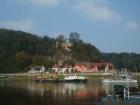
|
|
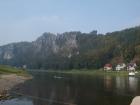
|
|
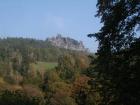
|
|
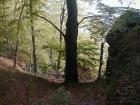
|
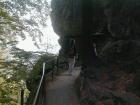
|
|
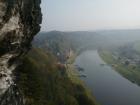
|
|
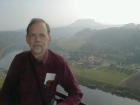
|
|
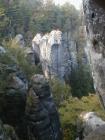
|
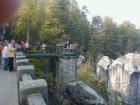
|
|
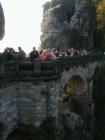
|
|
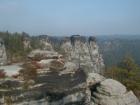
|
|
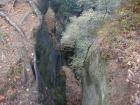
|
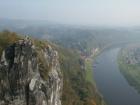
|
|
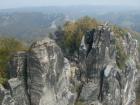
|
|
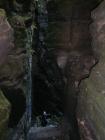
|
|
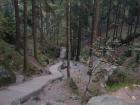
|
| The Sächische Schweiz
(the Switzerland of Saxony) |
|---|
Die Frauenkirche (the Church of the
Lady)
The Dresden Frauenkirche (Church of the
Lady), was under construction when I visited in 2003,
and it was consecrated in
2005 during a rare moment when Germans from all over got together
for a deeply symbolic celebration.
It doesn't exactly belong in my "Berlin trip" story, but
I put it in anyway.
This magnificent Baroque church was finished in 1743 and
was destroyed as part of the Allied bombing
of 13 February 1945. Starting in 1989, a movement pushed to
reconstruct the church.
Instead of a normal reconstruction, they referred to it as
an archäologischer Wiederaufbau
("archaeological restoration") because they used as many
of the original stones as possible.
Right now the old stones stand our in dark contrast with
the very light new stones, but over time the new stones will
darken and the church will look unified again. Details of this story are
moving and widely available. Suffice to say that this
building represents the best modern stonework in the world,
and the finished church is a worldwide symbol of reconciliation
and rebirth.
The sign in the second row below says:
BRÜCKEN BAUEN / VERSÖHNUNG LEBEN
(Build Bridges / Live for Reconciliation).
The restoration was financed through gifts from across the world.
America had its "Friends of the Frauenkirche" headed by
Henry Kissinger. Of the various stories, one was notable:
as a child, Günter Blobel witnessed the fall of this
church after it burned for three days. Later he became a
medical researcher in the US, and eventually donated a large
portion of his Nobel prize award to the restoration effort.
The church was widely known for many things: its beautiful
design, its organ, its dome made of stone and shaped like a bell.
Now the skyline of Dresden has been restored. I visited
Dresden in 2003 with the boyfriend of one of John's roommates.
He came from Dresden and was studying at the university there.
He had thought that the whole enterprise was a bit foolish,
that the money could have been better used elsewhere, but even
he came around to enthusiasm in the end.
(All of the pictures below came from the Internet.)
| 
